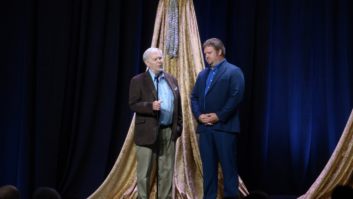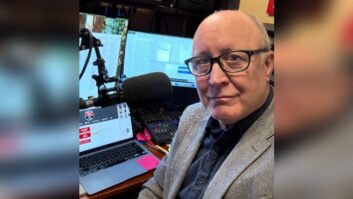I suspect you’re wondering the same thing: Is it possible that a $200 digital audio recorder is good enough for professional use in radio broadcasting?
I wish I could offer a simple “yes” or “no” answer but the story is not that simple. As with most things in life, there are grey areas.
(click thumbnail)The Zoom H2 Handy Recorder, priced at $199 list, is definitely a groundbreaking product — if for nothing else than by offering such a rich feature set for so low a price. It might even fit on a timeline of technology history as an example of how good China has become at designing and building complex electronic devices at an extremely low cost.
There are quite a few portable audio recorders now available, but this tiny, four-ounce model is no “me too” product. It uses an adjustable four-microphone array in a W-X/Y configuration to capture and decode audio in several formats up to 48 kHz at 24 bit resolution.
That means the H2 can be used in novel ways. For example, it can be mounted on top of a video camcorder to record audio in a 360 degree pattern on four tracks for conversion to 5.1 surround.
For more traditional radio broadcasting functions — say, recording news conferences or other live events — the H2 easily can be used with two mic capsules to record in a 90-degree pickup pattern as stereo or a dual mono mix in a 16 bit WAV or MP3 file. As a dual side-fire device, it also can be set in a front-rear pickup mode for face-to-face interviews.
By pressing the Play/Pause button while recording, the H2 creates a marker as a cue point. These marks, up to 99 of them, can be used as locators within BWF (Broadcast Wave Format) files. This embedded information can be useful in locating key segments of a recording quickly.
Like most audio recorders in this category, the H2 stores data to an SD flash card (up to 4 GB for about six hours in 16 bit/44.1 kHz mode). The card can either be removed for insertion into a Mac or Windows PC, or the recorder can be connected via USB 2.0 to act as a full-speed mass storage device.
In a separate function, the H2 also can serve as an audio interface for a personal computer. The user can directly record the output from the H2’s microphones or external inputs directly to the computer via a USB cable.
Using two AA batteries (alkaline, oxyride or rechargeable nickel-hydride), the device can record for four continuous hours. The batteries are easy to change by removing a thin plastic lid on the back of the recorder. An AC adapter is included.
Sibling rivalry
Product CapsuleZoom H2 Handheld Digital Recorder
Thumbs Up

- Full-featured portable digital audio recorder for $200
- Four-microphone W-X/Y configuration allows creativity in sound design
- Good battery life, long recording time on up to 4 GB SD flash card
- Features like compression, limiter, low-cut filter and marker for BWF metadata
- Choice of various WAV and MP3 recording formats
- Small, compact, 4 ounce package
Thumbs Down
- Flimsy, plastic case seems fragile
- Menu settings lost after SD card format
- Display screen small and hard to read
Price
$199
Contact
Samson Technologies | (631) 784-2200 | www.zoom.co.jpUnlike its big brother, the Zoom H4, the H2 has no XLR connectors. In addition to the built-in mic array, there is a mini stereo microphone input with 2.5 volt plug-in-power capability, plus a separate line-level input. Also available is a combo headphone/line out mini jack for playback and monitoring.
The H2 has an especially wide choice of signal processing functions for maintaining proper recording levels. There are choices of AGC (general and speech), compression (general, vocal, drum) and limiter (general and concert). These also can be turned off for completely manual control. There’s also a low-cut filter, two-second pre-record buffer and auto-record function.
In evaluating any portable audio recorder, I start by diving in to the user interface without reading the manual. I’ve found that if the functions are intuitive and clear without the operating instructions, it’s usually a sign of thoughtful design.
I’m pleased to say, for the most part, the H2 passed my test, though for aging eyes, glasses might be necessary to view the tiny text on the 1 inch wide, backlit, 128 x 64 dot display. Once I could see, I was able to zip right through most of the functions.
However, to my dismay, I found that after formatting the flash card, most of my chosen set-up parameters switched back to default. This also happened after one battery change but did not occur after another. I can’t explain the inconsistency.
I frequently re-format flash cards so this constant resetting is annoying, and I hope Zoom, in a future firmware update, allows the user’s preferred functions to be remembered until changed.
How does the H2 sound? Quite good for a $200 recorder. But come on, dreamers, use your common sense. The components and preamps in this type of device do not equal the sonic quality of high-end professional gear.
As a consumer-grade, general-purpose audio recorder, however, the Zoom H2 is a decent performer.
Radio folks
Perhaps more important to radio broadcasters who might be salivating at the prospects of a $200 digital audio recorder is the issue of durability.
Again, common sense helps. The H2 is made of thin, light plastic. Some switches feel fragile, and the hinged door covering the SD slot appears ready to snap off with a single heavy-handed touch. I wouldn’t bet on an H2 surviving a drop to a concrete sidewalk.
If a broadcaster seeks an audio recorder for hard daily use, the H2 is not the best choice. I would suggest a far more rugged (and expensive) unit like Sony’s PCM-D1 for that role. However, if treated gently, the H2 can certainly do the job and do it well. A workhorse, it’s not.
Used in the right creative hands, the H2 has the flexibility to go far beyond many traditional recorders. The experimental possibilities with wide stereo and surround sound fields are exciting, and no doubt will be explored by some with an artistic view of sound production.
A couple of years ago, when the first generation of low-cost portable digital records began appearing in the marketplace, a $200 device like the Zoom H2 would have been unimaginable. Now that it’s here, this remarkable little machine opens a new world of digital audio recording that just about anyone. Perhaps that’s the big story here.







